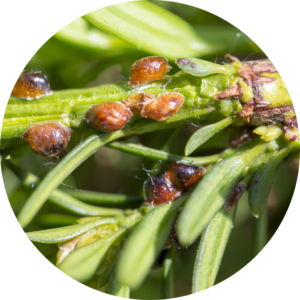Scale

Scale insects are small, largely immobile pests that use small mouthparts six to eight times the length of their bodies to feed on plant sap. They attach themselves to all parts of a tree and, in large enough numbers, can seriously hinder a specimen’s health and ability to grow.
These insects can be divided into two groups: armored scales, which secrete a protective cover over themselves, and soft scales, which are larger than the armored variety and resemble turtle shells. Like the armored scale, soft scales cover themselves with a wax; but unlike the former, the latter cannot detach from the covering it creates.
This protection helps to shield both species, so the best opportunity for extermination is to hit the scales when they are in their earlier “crawler” stage of development. Scales are in this phase right after hatching, which allows them the greater mobility needed to find a feeding spot. Insecticides can be effective during this period, but because of the relatively short window provided by this process, it’s critical that the scale development is monitored.
Using bio-friendly materials like horticultural oil is another good way to target scales directly while leaving their predators, like lady beetles and parasitic wasps, unharmed. This combination of cultural and chemical control can be a very successful way of curbing the scale population. Regular tree maintenance like proper irrigation, pruning to get rid of infected areas, and good landscaping practices can also aid in eliminating this pest.

